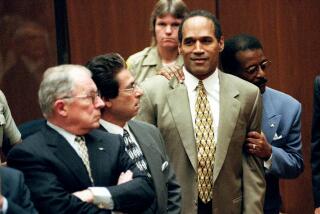Rashomon justice
- Share via
Arecent study published in the Harvard Law Review suggests that video evidence, however clear to one viewer -- or to eight Supreme Court justices -- may not be persuasive to another. The basis of the study was a 2007 case reviewed by the Supreme Court that involved a Georgia man who was paralyzed after a police officer rammed his car during a high-speed pursuit. A video of the chase, recorded by a camera in the squad car, dominated the justices’ examination. A federal appeals court in Atlanta had ruled for the driver, saying that he remained in control of his vehicle, but the justices disagreed and sided with the officer.
“We are happy to allow the videotape to speak for itself,” Justice Antonin Scalia wrote for the majority, and the video was uploaded to the court’s website. Which prompted the authors of the study to ask: “If so, whatdoes it say?” They showed the video to a random sample of more than 1,300 people and found that although “a fairly substantial majority did interpret the facts the way the court did ... members of various subcommunities did not. African Americans, low- income workers and residents of the Northeast, for example, tended to form more pro-plaintiff views of the facts than did the court. So did individuals who characterized themselves as liberals and Democrats.”
The mutability of video evidence is familiar to Angelenos who can remember the early 1990s, when the city was riveted by images of Los Angeles police officers striking and kicking Rodney G. King on a street in Lakeview Terrace. By the time that videotape had been featured in two criminal trials -- and Los Angeles had experienced a riot over the results of the first -- it was indelibly imprinted on the city’s conscience. Indelibly, but subjectively. For even after all that time, many police watched the tape and saw officers subduing a suspect who resisted arrest; most others saw those officers beating a defenseless man into submission. One tape. Multiple cultures.
We don’t deny the value of video as a source of powerful evidence, but as it goes from commonplace to ubiquitous, judges will have to learn the lesson that Angelenos long ago were taught: The camera exposes and illuminates. But what it illuminates is sometimes only partly on the screen; the rest lies in the consciousness and life experience of the viewer.
More to Read
A cure for the common opinion
Get thought-provoking perspectives with our weekly newsletter.
You may occasionally receive promotional content from the Los Angeles Times.






